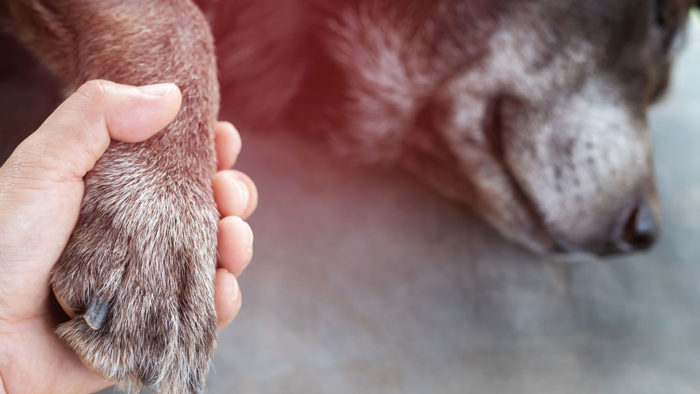All dogs have a maximum lifespan that cannot be exceeded; some are as low as eight to 10 years while others can extend as far as 15 years. As these canines get nearer to the end of their lives, they start displaying some signs that cannot be overlooked. These same signs can also be evident in terminally ill dogs that may not likely survive for long. In all, it is important to watch out for warning signs your dog is dying and help the canine to live the rest of its days happy.
As a pet parent, when your dog loses appetite completely, emaciates to a large extent, or finds it difficult to get comfortable, it is trying to pass on an important message that must be heeded.
Table of Contents
Watch Out For These Warning Signs Your Dog is Dying
1. Complete Loss of Appetite
When an aged dog or a sick one loses appetite completely, all is not well with the pup. This is because mealtime with its accompanying clicking sound of food bowls and rustling noise of the treat packets is one of their favorite. Even a dog that doesn’t eat much will still look up to mealtimes. Thus, whenever you notice this expectant behavior diminish or your pooch starts eating very little or not eating at all, then, it is trying to communicate something to you.
Loss of appetite may mean that your fur buddy is in pain or is ill, though the illness may not always be the terminal kind. What every pet parent should note is that the canines are like humans and will not care about eating food during their end time. A prolonged loss of appetite calls for a visit to the vet to get to the root of the matter.
2. Extreme Emaciation or Weight Loss
Loss of weight is among the first indicators of ill health in dogs. From being ill, a pup loses appetite, and naturally, weight loss follows. A dog nearing its end will experience several physical changes as a result of stress beyond its control. Several factors can lead to weight loss like loss of appetite, dehydration, old age, and liver failure. Again, sickness or old age in a dog causes reduced mobility and it goes without saying that the dog will lose muscle mass.
Even though extreme emaciation is considered to be a sign of terminal illness, it can also result from conditions like digestion difficulties and others like it. Don’t just assume the worst with an emaciated dog until it is pronounced by a vet.
3. Total sluggishness or lethargy

As people get older, they tend to slow down; the same is applicable to the canine population. With old age, a dog’s energy level lowers and it just can’t bring itself to run. As the pup’s natural high-spirit diminishes, you will notice it lying at one spot all the time. What the dog is doing at that stage is conserve the little energy it has left. In addition to lethargy, the pup will also lose interest in its favorite toys, even new exciting ones won’t bring any reactions from the canine. It will ignore any attempt to draw it out and sleep for most of the day.
4. Inability to Get Comfortable
As dogs get older, their joints and ligaments become very painful and when this happens, getting comfortable becomes a hard struggle. This is a sure sign that your canine companion is nearer to the end. The discomfort may not only be physical, it can also be mental, leading to confusion; this will, in turn, lead the dog to become stressed and irritable with their surroundings. When you notice your pooch struggling for comfort, the best you can do is provide it with the best possible spot to rest. You can as well invest in an orthopedic dog’s bed, complete with what is referred to as a memory foam mattress.
5. Vomiting
Several factors can lead to vomiting, like viruses, infections, motion sickness, and many more. However, an aging dog that is in its last stage of life is likely to vomit ceaselessly. The reason for this is that the pup’s digestive system is already shutting down, leaving a lot of its food intake undigested. When the dog is left with a lot of undigested food, nausea sets in, and in order to clean up the stomach, the dog just has to throw up. Under this circumstance, your best bet is to seek professional advice from the vet.
6. Loss of Coordination
When a pup that is normally athletic begins to stumble in movement and start experiencing difficulty with muscle control, it may mean that loss of coordination has set in. When the sense of coordination is lost, balance issues equally start and this is a sure indication that your canine companion may be dying. Balance issues can result from some underlying diseases or serious injuries, but they can also stem from ear infections and other minor health issues. So, do not panic too much, just seek the counsel of your local vet to be sure.

7. Labored, Difficult, or Odd Breathing
A dog that is close to death will experience a breakdown in its normal body function; this can lead to odd breathing. We must acknowledge the fact that respiratory issues can be common among the canine population and can be caused by several factors like heart failure and respiratory organ disorders. When a dog that could normally run long distances for hours without issues suddenly starts panting from exhaustion after running a short distance, something is seriously wrong.
At this stage, inhaling and exhaling will take significantly longer, catching their breath becomes rather difficult, and most of the time, breathing is labored. The breathing may come very fast, become very slow, and then go back to normal. This process may draw out for a long time before the dog finally passes. Always seek the assistance of your local vet at this stage.
8. Bad Skin
A dying dog experiences dehydration which greatly affects the skin. Even with dense-coated dogs, the signs of dehydration will be pretty obvious on your four-legged buddy’s skin. With time, the condition and the quality of the dog’s fur begin to get worse. The fur first gets dry and then becomes very rough and no amount of effort can get it back to its normal tip-top condition.
Read Also: 12 Dogs With Curly Tails
9. Twitching
As a dog is aging, it would naturally lose muscle control and this is what leads to twitching. Twitching may not always be a bad sign as it can be caused by several factors and like human beings; pups can twitch without any good reason. While pain and dehydration can lead to twitching, there are still very serious twitching that goes non-stop or the type that leads to loss of balance; this may be an indication of a serious health issue. When you notice this, bring the vet in to rule out any treatable disease.
10. Lowered Body Temperature
As they age, members of the canine population are likely to lose that natural ability to regulate their own body temperature. There may be other health issues that may lead to loss of body heat. For this reason, dogs that are close to their end will experience lower body temperature. Pet owners in colder climates can help their aging dogs with the use of hot water bottles, warm blankets, or heated beds when the body temperature goes very low.
Recap Of Warning Signs Your Dog Is Dying
- Complete Loss of Appetite
- Extreme Emaciation or Weight Loss
- Total sluggishness or lethargy
- Inability to Get Comfortable
- Vomiting
- Loss of Coordination
- Labored, Difficult, or Odd Breathing
- Bad Skin
- Twitching
- Lowered Body Temperature
What You Can Do For Your Dying Dog
Death might be inevitable but it doesn’t have to be painful. To make the last days of your dog more pleasant, certain factors will come into play.
- Provide delicious and nutritious meals to boost the appetite
- Depending on their condition, your presence or absence might be necessary
- Keep the dog warm, your pooch needs warmth now more than ever
- Pay regular visits to the vet and get medications that can ease the pain the dog is going through
- You can resort to euthanasia if the dog is in pain and suffering.
